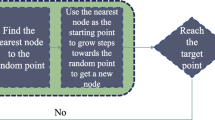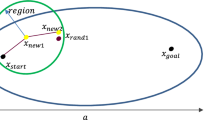Abstract
Autonomous navigation is a significant segment of mobile robotics, and for reliable autonomous navigation, optimal trajectory planning is the fundamental requirement. In mobile robotics, planning algorithms are implemented to attain optimality in trajectory planning by solving the problems such as path length minimization, smoother trajectories, low computational load, time/ space complexity, etc., that degrade the performance of the path planning technique. This research paper primarily focuses on generating smooth trajectories with the shortest path length by linking the Bidirectional Rapidly exploring Random Tree (B-RRT) with a modified Bezier curve technique termed Smooth-BRRT (S-BRRT). The proposed S-BRRT technique generates smoother trajectories by considering the high number of control points associated with the Bezier curve technique. The selection criteria for control points will be adaptive, which means the number of control points may increase or decrease depending upon the path length, grid cell size, mobile robot dimension, maximum acceleration of mobile robot, etc. The proposed S-BRRT technique is implemented in various simulated environments, and it is experimentally obtained that the path length is reduced by 15.03%, the number of sharp turns is reduced by 100%, and time lag is reduced by 27.01%. The proposed S-BRRT technique is also trialed and tested in various real-world experiments. The result shows a 100% reduction in the collision, the time lag is reduced by 66.23%, and the velocity error is reduced to 57.52%, concerning the results obtained with renowned conventional approaches.
























Similar content being viewed by others
References
Singh R, Nagla KS (2019) A modified sensor fusion framework for quantifying and removing the effect of harsh environmental condition for reliable mobile robot mapping. Sens Rev 39:456–472. https://doi.org/10.1108/SR-10-2018-0272
Singh R, Nagla KS (2020) Comparative analysis of range sensors for the robust autonomous navigation—a review. Sens Rev 40:17–41. https://doi.org/10.1108/SR-01-2019-0029
Jan GE, Chang KY, Parberry I (2008) Optimal path planning for mobile robot navigation. IEEE/ASME Trans Mechatron 13:451–460
Ko MH, Ryuh B-S, Kim KC et al (2014) Autonomous greenhouse mobile robot driving strategies from system integration perspective: review and application. IEEE/ASME Trans Mechatron 20:1705–1716
Mac TT, Copot C, Tran DT, de Keyser R (2016) Heuristic approaches in robot path planning: a survey. Robot Auton Syst 86:13–28. https://doi.org/10.1016/j.robot.2016.08.001
Zhang H, Lin W, Chen A (2018) Path planning for the mobile robot: a review. Symmetry (Basel) 10:450
Véras LGDO, Medeiros FLL, Guimaráes LNF (2019) Systematic literature review of sampling process in rapidly-exploring random trees. IEEE Access 7:50933–50953
Lamini C, Benhlima S, Elbekri A (2018) Genetic algorithm based approach for autonomous mobile robot path planning. Procedia Comput Sci 127:180–189
Wei K, Ren B (2018) A method on dynamic path planning for robotic manipulator autonomous obstacle avoidance based on an improved RRT algorithm. Sensors 18:571
Ma J, Liu Y, Zang S, Wang L (2020) Robot path planning based on genetic algorithm fused with continuous Bezier optimization. Comput Intell Neurosci 2020:1–10
Liu S, Sun D (2013) Minimizing energy consumption of wheeled mobile robots via optimal motion planning. IEEE/ASME Trans Mechatron 19:401–411
Krishnan J, Rajeev UP, Jayabalan J, Sheela DS (2017) Optimal motion planning based on path length minimisation. Robot Auton Syst 94:245–263
Urcola P, Lázaro MT, Castellanos JA, Montano L (2017) Cooperative minimum expected length planning for robot formations in stochastic maps. Robot Auton Syst 87:38–50
Zhao J, Cheng D, Hao C (2016) An improved ant colony algorithm for solving the path planning problem of the omnidirectional mobile vehicle. Math Probl Eng 2016:1–10
Sergiyenko OY, Tyrsa VV (2020) 3D optical machine vision sensors with intelligent data management for robotic swarm navigation improvement. IEEE Sens J 21:11262–11274
Liu H, Luo S, Lu J (2019) Method for adaptive robust four-wheel localization and application in automatic parking systems. IEEE Sens J 19:10644–10653
Author information
Authors and Affiliations
Corresponding author
Additional information
Publisher's Note
Springer Nature remains neutral with regard to jurisdictional claims in published maps and institutional affiliations.
Rights and permissions
Springer Nature or its licensor (e.g. a society or other partner) holds exclusive rights to this article under a publishing agreement with the author(s) or other rightsholder(s); author self-archiving of the accepted manuscript version of this article is solely governed by the terms of such publishing agreement and applicable law.
About this article
Cite this article
Singh, R. Optimized trajectory planning for the time efficient navigation of mobile robot in constrained environment. Int. J. Mach. Learn. & Cyber. 14, 1079–1103 (2023). https://doi.org/10.1007/s13042-022-01684-7
Received:
Accepted:
Published:
Issue Date:
DOI: https://doi.org/10.1007/s13042-022-01684-7




